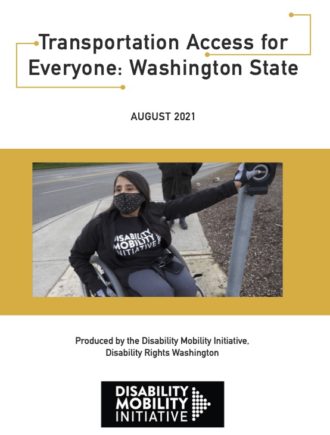
Disability Rights Washington released a report this week that is so good it should be considered mandatory reading for everyone working in transportation in our state. The word “report” doesn’t really do it justice because “Transportation Access for Everyone: Washington State” is filled with personal stories from people all over the state who are being left behind or seriously inconvenienced daily by our transportation infrastructure and services. The report then summarizes some of the issues people face and provides a non-exhaustive list of recommendations for politicians, transportation departments and transit agencies.
But even if you aren’t a politician or transportation staffer, the personal stories are very compelling. The term “disability” covers such a wide range of lived experiences, and the barriers people face are often caused by a lack of consideration in planning and implementation of policies, priorities, services and infrastructure design. Simply following the bare minimum to meet the Americans with Disabilities Act legal requirements is not good enough. Earmarking some funding for paratransit in a budget overflowing with highway spending is not good enough, either. Instead, we should work towards “radical inclusion,” which means being familiar with and serving as many people’s needs as possible. From the report authors:
We did not intend to create an exhaustive list of the needs of transit-reliant disabled people or a complete set of policy recommendations. Instead, this report should
be viewed as a starting point for policy- makers, elected officials, transit agencies, transportation departments, transportation advocates and civil and transportation engineers, and those in related fields, to humbly perceive their ignorance of the daily experiences of people who live differently than them and understand the urgent need for “radical” inclusion of disabled nondrivers in the planning processes across every level of our transportation systems and to begin, with urgency, to practice that inclusion.
— Advertisement —
While the report has a lot of recommendations, it makes two “major actions”:
- Shift resources to prioritize funding accessible pedestrian infrastructure and reliable transit service.
- Look to nondrivers as transportation decision makers and experts.
Big thanks to Disability Rights Washington and its Disability Mobility Initiative, led by Anna Zivarts, for this report. Thanks also to the more than 125 disabled nondrivers who shared their stories with the report’s authors. Check it out here.








Comments
One response to “Disability Mobility report makes a powerful, story-driven case for transit and street improvements across Washington State”
Disability mobility is important, but sometimes, it’s special place under the law results in tunnel vision. For instance, a lot of ramps have tight switchbacks making them horrible for bikes, but they’re still considered acceptable design because the ADA on cares about wheelchairs.
Paratransit is another example. The law requires that if an area has fixed transit, it must have paratransit, but the correlary is that if an agency can’t afford the cost of paratransit in an area, it can’t run regular transit there either. Thus, the law ends up not actually resulting in more service for the disabled, but rather, less service for everybody else. A few years ago, community transit used ADA as a reason to justify cutting all Sunday service (since reinstated). By completely eliminating it, they could get rid of the expensive paratransit obligation, thereby resulting in more savings per rider pain.
ADA was meant to be about buildings, where adding a wheelchair ramp contributes negligibly to construction cost. Then, it got extended to transit, where the ongoing cost burden is huge (about $38/boarding). All transit riders pay for it with longer waits and less service, while the rest of the public just drives their car and doesn’t care.